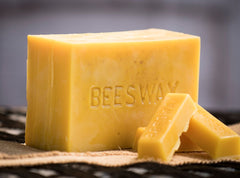
How To: Using Bees Wax For Wood Finishing
Yes, I am well aware of the droning I do about questions I hear repeatedly while selling honey. I am trying to make 2020 the year of self improvement and constructive education. So hear goes - every time I put bees wax bars on the farmer's market sales table, within 30 minutes someone asks 'What do you use beeswax for"? Instead of complaining about the frequency of this question, I am going to give you a looooooong list of blog posts detailing 'how-tos' for all you would-be D.I.Y.ers on the benefits and uses of this AMAZING natural product. The intro conversation is the most obvious - wood polish.
There are some out there that will advocate that you go Au Natural with your ingredients. I am going to give you 2 options as each has it's pros and cons.
The Ingredients
- 1 pound bar beeswax
- Mineral oil OR Olive oil (these are the two options - differences to be detailed shortly), 3 cups either option
- 25 to 30 drops of Vitamin E oil or Grapefruit Seed Extract (use with olive oil option only
- Essential oil for scent (optional) Lemon, lavender, peppermint
Want some pictures as examples - here you go:





Again, the natural option is to combine beeswax with olive oil. Just so you are aware the portions for either set of instructions is the same.
The Process
Option 1
Fill a sauce pan half way with water. This is going to function as a double boiler. Use a hammer and chisel to break off a few chunks of bees wax and place into a Pyrex measuring cup and place in the pot of water. Turn the heat on medium and heat until wax is completely melted. Add the appropriate amount of wax until you reach 2/3 cup. Stir intermittently until all the chunks have melted.
Remove from heat and add olive oil to melted bees wax. Continue to stir. You can reintroduce the combination to the double boiler to help both components bind. Then add the vitamin E and essential oils and stir. Olive oil, like most natural oils, will eventually go rancid (the CON with this option). Vitamin E is an antioxidant and will arrest that process which will keep your polish fresh smelling like freshly harvested bees wax. You can use the essential oil of your choice if you prefer a different scent. The bees wax smell will give way to the essential oil you choose (the PRO) - they are very concentrated.
Option 2
The preparation is the same. Be very careful - mineral oil is extremely flammable. Combine the wax and oil away from the stove - and make certain the burner is OFF. This option, while it does produce a beautiful finish (the PRO), does tend to dry out relatively quickly, leaving you with a block of bees wax that smells like mineral oil (the CON). If you do go this route, be sure to put the polish in a seal-able tin or canning jar.
Application
Use a Scotch-Brite reusable towel to work the polish into the wood surface (cutting board, wooden bowl, table, etc). Use a shop towel to buff out the excess polish.
